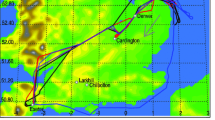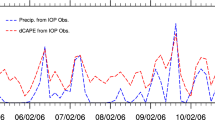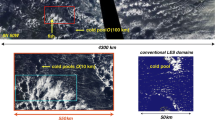Abstract
In this study, a one-dimensional ensemble-average model is used to simulatethe Atlantic Stratocumulus Transition Experiment firstLagrangian, where the same airmass was followed from the subtropical high pressure region en route towards the trade wind region. The airmass experiences increasing sea-surface temperature and achange from subsidence to weak ascent on its way south. Thiscauses the marine boundary layer (MBL)to grow and the cloud deck to change from a solid stratocumulus deck tomore broken stratocumulus clouds with cumulus cloudsdeveloping beneath, and reaching up into the stratocumulus clouds.
A control run is analyzed and compared in detail with theobservations. Both a statistical evaluation and a more subjective evaluation are performed, where both establish confidencein the model performance. The model captures the MBL growth and the cloudliquid water, as well as the drizzle flux, is well predicted by the model.A sensitivity study was performed with the objective of examining theMBL and the cloud response to external and internal 'forces'.The results show that, if drizzle formation is not allowed,unrealistically high cloud liquid water mixing ratios are predicted. Even though the drizzle flux is very small, it is still important for the water budget of the MBL and for the boundary-layer dynamics.We also found that the sea-surface temperature increase is more important for the increasing cloud top height than the synoptic-scale divergence fields. However, the synoptic-scale subsidence is crucial during the first day, when the sea-surface temperature was constant, in keepingthe cloud top at a constant height. Drizzle evaporation below the cloud base seems to be important for below-cloud condensation. The drizzle predictions are significantly altered when the prescribed cloud droplet and/or drizzle drop numbers are altered.
Similar content being viewed by others
References
Albrecht, B. A., Bretherton, C. S., and Johnson, D.: 1995, 'The Atlantic Stratocumulus Transition Experiment (ASTEX)', Bull. Amer. Meteorol. Soc. 76, 889-904.
Andrén, A.: 1990, 'Evaluation of a Turbulence Closure Scheme Suitable for Air-Pollution Applications', J. Appl. Meteorol. 29, 224-239.
Bougeault, P.: 1985, 'The Diurnal Cycle of Marine Stratocumulus Layer: A Higher-Order Model Study', J. Atmos. Sci. 42, 2826-2843.
Bretherton, C. S. and Pincus, R.: 1995, 'Cloudiness and Marine Boundary Layer Dynamics in the ASTEX Lagrangian Experiments. Part I. Synoptic Setting and Vertical Structure', J. Atmos. Sci. 52, 2707-2723.
Bretherton, C. S., Austin, P., and Siems, S. T.: 1995, 'Cloudiness and Marine Boundary Layer Dynamics in the ASTEX Lagrangian Experiments. Part II. Cloudiness, Drizzle, Surface Fluxes and Entrainment', J. Atmos. Sci. 52, 2724-2751.
Bretherton, C. S., Krueger, S. K., Wyant, M. C., Bechtold, P., van Meijgaard, E., Stevens, B., and Teixeira, J.: 1999, 'A GCSS Boundary Layer Model Intercomparison Study of the First ASTEX Lagrangian Experiment', Boundary-Layer Meteorol. 93, 341-380.
de Roode, S. R. and Duynkerke, P. G.: 1997, 'Observed Lagrangian Transition of Stratocumulus into Cumulus during ASTEX: Mean State and Turbulence Structure', J. Atmos. Sci. 54, 2157-2173.
Driedonks, A. G. M. and Duynkerke, P. G.: 1989, 'Current Problems in the Strato-Cumulus-Topped Atmospheric Boundary-Layer', Boundary-Layer Meteorol. 46, 275-303.
Duynkerke, P. G., Zhang, H. Q., and Jonker, P. J.: 1995, 'Microphysical and Turbulent Structure of Nocturnal Stratocumulus as Observed during ASTEX', J. Atmos. Sci. 52, 2763-2777.
Enger, L.: 1990, 'Simulation of Dispersion in Moderately Complex Terrain. Part A. The Fluid Dynamic Model', Atmos. Environ. 24A, 2431-2446.
Fairall, C. W., Bradley, E. F., Rogers, D. P., Edson, J. B., and Young, G. S.: 1996, 'Bulk Parameterization of Air-Sea Fluxes for Tropical Ocean-Global Atmosphere Coupled-Ocean Atmosphere Response Experiment', J. Geophys. Res. 101, 3747-3764.
Fu, Q. and Liou, K. N.: 1992, 'On the Correlated k-Distribution Method for Radiative Transfer in Scattering Atmospheres, Ph.D. Dissertation, University of Utah, 259 pp.
Fu, Q. and Liou, K. N.: 1992, 'On the Correlated k-Distribution Method for Radiative Transfer in Nonhomogeneous Atmospheres', J. Atmos. Sci. 49, 2139-2156.
Fu, Q. and Liou, K. N.: 1993, 'Parameterization of the Radiative Properties of Cirrus Clouds', J. Atmos. Sci. 50, 2008-2025.
Fu, Q., Krueger, S. K., and Liou, K. N.: 1995, 'Interactions of Radiation and Convection in Simulated Tropical Cloud Clusters', J. Atmos. Sci. 52, 1310-1328.
Gunn, R. and Kinzer, G. D.: 1949, 'The Terminal Velocity of Fall for Waterdrops in Stagnant Air', J. Meteorol. 6, 243-248.
Hanna S. R.: 1994, 'Mesoscale Meteorological Model Evaluation Techniques with Emphasis on Needs of Air Quality Models', in R. A. Pielke and R. P. Pearce (eds.), Mesoscale Modeling of the Atmosphere, pp. 47-62.
Liou, K. N.: 1992, Radiation and Cloud Processes in the Atmosphere, Oxford University Press, 487 pp.
Liou, K. N., Fu, Q., and Ackerman, T. P.: 1988, 'A Simple Formulation of the Delta-Four-Stream Approximation for Radiative Transfer Parameterizations', J. Atmos. Sci. 45, 1940-1947.
Liu, W. T., Katsaros, K., and Businger, J. A.: 1979, 'Bulk Parameterization of Air-Sea Exchanges of Heat and Water Vapour Including the Molecular Constraints at the Interface', J. Atmos. Sci. 36, 1722-1735.
Nicholls, S.: 1984, 'The Dynamics of Stratocumulus: Aircraft Observations and Comparison with a Mixed Layer Model', Quart. J. Roy. Meteorol. Soc. 110, 783-820.
Pielke, R. A.: 1984, Mesoscale Meteorological Modeling, Academic Press, 599 pp.
Rogers, R. R.: 1976, A Short Course in Cloud Physics, Pergammon Press, 235 pp.
Svensson, G.: 1998, 'Model Simulations of the Air Quality in Athens, Greece, during the MEDCAPHOT-TRACE Campaign', Atmos. Environ. 32, 2239-2268.
Tjernström, M.: 1987, 'A Study of Flow over Complex Terrain Using a Three Dimensional Model. A Preliminary Model Evaluation Focusing on Stratus and Fog', Ann. Geophys. 5B, 469-486.
Tjernström, M.: 1988, 'Numerical Simulations of Stratiform Boundary-Layer Clouds on the Meso-γ-Scale. Part I. The Influence of Terrain Height Differences', Boundary-Layer Meteorol. 44, 33-72.
Tjernström, M. and Koračin, D.: 1995, 'Modeling the Impact of Marine Stratocumulus on Boundary-Layer Structure', J. Atmos. Sci. 52, 863-878.
Tripoli, G. J. and Cotton, W. R.: 1980, 'A Numerical Investigation of Several Factors Contributing to the Observed Variable Intensity of Deep Convection over South Florida', J. Appl. Meteorol. 19, 1037-1063.
Author information
Authors and Affiliations
Rights and permissions
About this article
Cite this article
Svensson, G., Tjernström, M. & Koračin, D. The Sensitivity Of A Stratocumulus Transition: Model Simulations Of The Astex First Lagrangian. Boundary-Layer Meteorology 95, 57–90 (2000). https://doi.org/10.1023/A:1002434314651
Issue Date:
DOI: https://doi.org/10.1023/A:1002434314651




